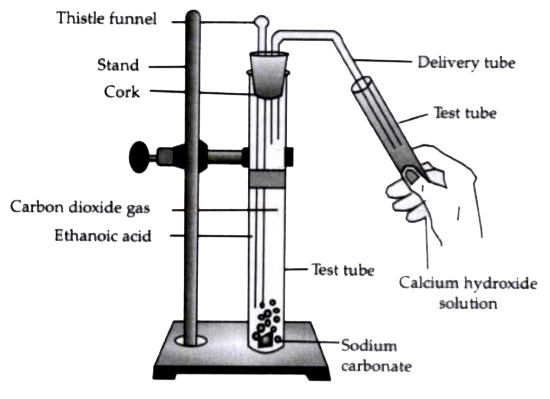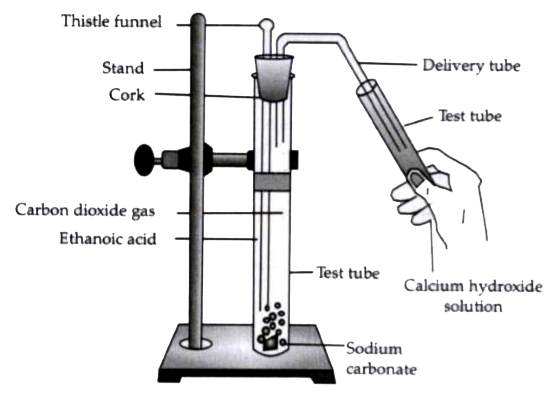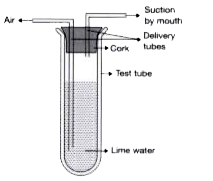Parth took equal lengths of Magnesium ribbon in test tubes A & B. Sulphuric acid - is added to test tube A while acetic acid is added to test tube B. In which case would the reaction occur more vigorously and why. Write the chemical equations for reactions in test tube A.
Step-by-Step Solution:
1. Identify the Reactants:
- In test tube A, we have magnesium ribbon (Mg) and sulfuric acid (H₂SO₄).
- In test tube B, we have magnesium ribbon (Mg) and acetic acid (CH₃COOH).
2. Determine the Strength of Acids:
- Sulfuric acid (H₂SO₄) is a strong acid.
- Acetic acid (CH₃COOH) is a weak acid.
3. Predict the Reaction:
- Strong acids react more vigorously with metals compared to weak acids. Therefore, the reaction in test tube A (with sulfuric acid) will occur more vigorously than in test tube B (with acetic acid).
4. Write the Chemical Equation for Test Tube A:
- The reaction between magnesium and sulfuric acid can be represented as:
Mg+H2SO4→MgSO4+H2
- Here, magnesium displaces hydrogen from sulfuric acid, resulting in the formation of magnesium sulfate (MgSO₄) and hydrogen gas (H₂).
5. Conclusion:
- The reaction in test tube A will occur more vigorously due to the presence of a strong acid (H₂SO₄), while the reaction in test tube B will be much weaker due to the weak acid (CH₃COOH).
---
- In test tube A, we have magnesium ribbon (Mg) and sulfuric acid (H₂SO₄).
- In test tube B, we have magnesium ribbon (Mg) and acetic acid (CH₃COOH).
- Sulfuric acid (H₂SO₄) is a strong acid.
- Acetic acid (CH₃COOH) is a weak acid.
- Strong acids react more vigorously with metals compared to weak acids. Therefore, the reaction in test tube A (with sulfuric acid) will occur more vigorously than in test tube B (with acetic acid).
- The reaction between magnesium and sulfuric acid can be represented as:
Mg+H2SO4→MgSO4+H2
- Here, magnesium displaces hydrogen from sulfuric acid, resulting in the formation of magnesium sulfate (MgSO₄) and hydrogen gas (H₂).
- The reaction in test tube A will occur more vigorously due to the presence of a strong acid (H₂SO₄), while the reaction in test tube B will be much weaker due to the weak acid (CH₃COOH).
Topper's Solved these Questions
- DIKSHA QUESTIONS Book:OSWAL PUBLICATIONChapter:DIKSHA QUESTIONS Exercise:ACIDS,BASES AND SALTS (LONG ANSWER)
Explore 22 Videos
- DIKSHA QUESTIONS Book:OSWAL PUBLICATIONChapter:DIKSHA QUESTIONS Exercise:ACIDS,BASES AND SALTS (MULTIPLE CHOICE QUESTIONS)
Explore 17 Videos
- DIKSHA QUESTIONS Book:OSWAL PUBLICATIONChapter:DIKSHA QUESTIONS Exercise:ACIDS,BASES AND SALTS (VERY SHORT ANSWER)
Explore 5 Videos
- CHEMICAL REACTIONS AND EQUATIONSBook:OSWAL PUBLICATIONChapter:CHEMICAL REACTIONS AND EQUATIONSExercise:CASE-BASED MCQs
Explore 29 Videos
- METALS AND NON - METALS Book:OSWAL PUBLICATIONChapter:METALS AND NON - METALS Exercise:CASE - BASED MCQs
Explore 29 Videos
Similar Questions
Equal lengths of Mg ribbon are taken in test tubes A and B. Hydrochloric acid is added to test tube A. While acetic acid is added to test tube B. In which case the reaction would occur more vigorously and why? Write the chemical equations for reactions in test tube A and B.
View SolutionEqual lengths of magnesium ribbons are taken in test tubes A and B. Hydrochloric acid (HCl) is added to test tube A, while acetic acid (CH3COOH) is added to test tube B. In which test tube will the fizzing occur more vigorously and why?
View Solution
Knowledge Check

Name the gas released in test tube B.AOxygenBCarbon dioxideCHydrogenDNitrogen
Write the reaction involved in test tube A?ACH3COOH+Na2CO3→2CH3COOH+H2OB2CH3COOH+Na2CO3→2CH3COONa+H2OCCH3COOH+Na2CO3→2CH3COONa+CO2D2CH3COOH+Na2CO3→2CH3COONa+H2O+CO2
Equal lengths of magnesium ribbons are taken in test tubes A and B. Hydrochloric acid (HCl) is added to test tube A, while acetic acid (CH3COOH) is added to test tube B. Amount and concentration taken for both the acids are same. In which test tube will the fizzing occur more vigorously and why?
View SolutionEqual lengths of magnesium ribbons are taken in test tubes A and B. Hydrochloric acid (HCl) is added to test tube A, while acetic acid (CH3COOH) is added to test tube B. Amount and concentration taken for both the acids are same. In which test tube will the fizzing occur more vigorously and why?
View Solution
Write the chemical name of the substance taken in the test tube.
View SolutionEqual lengths of magnesium ribbons are taken in test tubes A and B. Hydrochloric acid (HCl) is added to test tube A, while acetic acid (CH3COOH) is added to test tube B. Amount and concentration taken for both the acids are same. In which test tube will the fizzing occur more vigorously and why?
View SolutionEqual amounts of sodium hydrogencarbonate are taken in two test tubes A and B. Acetic acid is added to test-tube A whereas an equal volume of hydrochloric acid is added to test-tube B. In which test-tube, effervescence will occur more vigorously and why?
View SolutionBlue coloured CuSO4 is taken in two test tubes A and B. Zinc granules are added to test tube A and small iron piecces are added to test tube B. Explain the observations in each acse by giving reasons.
View Solution